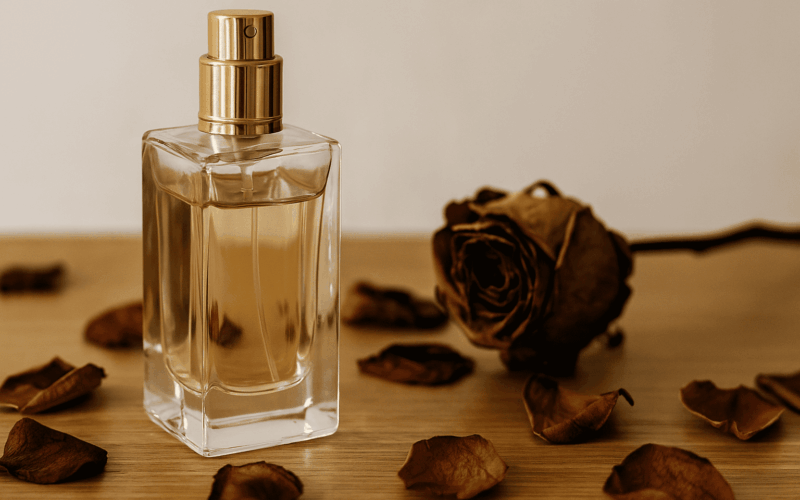Some fragrances become part of our memories. They remind us of people, cities, moments. Often we reach for a bottle not for the scent itself, but for the story it carries. Yet over time, perfumes change. Sometimes subtly, sometimes abruptly. And then comes the moment when your favorite scent smells off: flatter, sourer, or just wrong. Is this natural aging or a sign that it’s time to say goodbye?
The shelf life of perfume is a delicate matter. Most brands don’t print an exact expiration date, and if they do, it’s more a guideline than a rule. But there are objective signs to help you assess a perfume’s condition. When you know what to look for and how to store a fragrance, you can extend its life for years without compromising quality.
Chemistry and physics: how perfumes age
Every perfume is a complex blend of volatile compounds. The more intricate the formula, the more dynamic—and the more prone to oxidation. Citrus, aldehydes, green, and aquatic notes are especially fragile: they’re the first to lose freshness and can develop sharp or synthetic odors. Woody and resinous accords, especially those rich in musk or amber, are much more stable.
Aging also depends on packaging type. Spray bottles maintain a better seal than open-flask designs. Every time you remove a cap and dip a finger or stick into the fragrance, you expose it to air, accelerating breakdown. That’s why vintage perfumes in dab bottles often lose their original character even if barely used.
Temperature is another enemy. At 25°C, oxidation processes accelerate significantly compared to storage at 10–15°C. That makes bathroom shelves one of the worst places to keep perfume, especially if exposed to light. UV rays degrade molecules, particularly naturals like essential oils. Pigmentation can change too—liquid may darken or become cloudy.
Manufacturer shelf life: rules and realities
Most brands print a 36-month expiration after opening. This is a European regulatory requirement for cosmetics, including perfumes. But in reality, many perfumes can last 5, 10, even 20 years—especially those made before the mid-2000s when formulations were more robust.
It’s important to note that a spoiled scent is not necessarily dangerous—it just no longer reflects the perfumer’s intent. Even if it smells “different,” it’s rarely toxic. Exceptions include bottles with sediment, mold, or a strong acetone odor—those should be discarded.
Sometimes packaging or regulations change, and newer batches display an expiration date, even if older ones didn’t. This doesn’t mean a drop in quality—it’s often a marketing or compliance update, especially from international luxury brands.
An interesting detail: extraits and concentrated perfumes often last longer than eau de toilette. They contain more oils and less alcohol, evaporate slower, and resist aging better. However, they are also more sensitive to humidity and require stricter storage conditions.
How to tell if your perfume has gone bad
There are a few clear signs a perfume has aged poorly. First is color change. If the liquid darkens, becomes cloudy, or shows sediment, that’s a red flag—especially if the scent was originally clear or pale.
Second is a harsh opening smell. Sometimes, the top notes hit your nose with an acetone or vinegar blast. This happens when alcohol oxidizes and the top molecules break down. The heart and base may still be wearable—but the perfume’s structure has been compromised.
Third is loss of projection and longevity. If a scent that used to last 6–8 hours now disappears in 30 minutes, it’s not just your skin or the weather. It’s likely that storage conditions disrupted the balance of the fragrance.
Sometimes an off perfume can be “rescued”: if the issue is alcohol buildup near the nozzle, a gentle wipe with an alcohol swab may help. But if the smell is consistently unpleasant or the scent causes discomfort, it’s better to let go without regret.
How to extend a fragrance’s life
The primary rule is stable storage conditions. Perfume does best in a cool, dry, dark place. A fridge isn’t necessary—a drawer with a stable temperature around 15°C and no direct light is ideal. Some collectors even use wine coolers, which maintain steady humidity and minimal vibration.
Next is minimizing air contact. Each time you open a non-spray bottle, oxygen enters. So avoid using these bottles daily. For regular wear, use a travel spray or rollerball with a tight seal.
Also consider bottle position. Store bottles upright to avoid contact between the liquid and cap or sprayer. This is especially true for metal caps, as alcohol vapors can react and alter the formula. Avoid frequent movement or shaking of the bottle when not in use.
And finally, trust your instincts. Sometimes a fragrance feels different not because it has changed, but because you have—your skin, hormones, or even the season. If unsure, do a blind test: ask someone to spray the perfume on a paper strip and revisit it a day later. See how it feels without any visual bias.
When it’s time to let go
The decision to discard a perfume is deeply personal. Some keep vintage scents as keepsakes, even if they no longer smell good. Others toss a bottle at the first sign of change. There’s no universal rule, but some useful criteria include:
- the scent causes irritation or unpleasant reactions
- it differs from the original by over 70% and no longer brings joy
- the bottle leaks or is physically damaged
Some repurpose “expired” perfumes for linen drawers, stationery, or closet sachets. This can be a sustainable way to use what’s left. But remember, scent is one of the most emotionally sensitive senses—if it becomes mentally or physically toxic to you, it’s best to let it go.
Today, more brands are working to create stable and environmentally friendly formulas that last longer and are safer for both people and the planet. Learn more in our article on “Sustainability in perfumery: responsible brands and modern practices”
Questions and answers
Yes, but keep it above +5°C and in airtight packaging. Avoid temperature swings and condensation buildup.
Check color, texture, and longevity. Even if the scent seems fine, its structure may have already deteriorated.
Not at all. It’s a guideline, not a rule. If your perfume smells pleasant and hasn’t changed much, it’s still usable.

